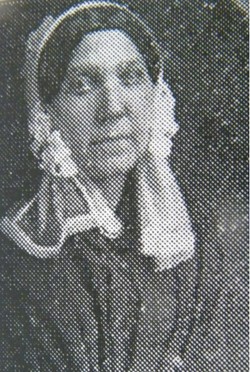Written by Jill M. Staake
Born: July 3, 1796, Charleston, South Carolina
Born: July 3, 1796, Charleston, South Carolina
S.T.E.A.M. Powers
- Natural Science Artist
- Painted many of the plants and insects that appear in John Audubon's famous works
Her Story
Like many women of her time and place, Maria Martin Bachman was brought up to be an ornamental part of the background. A woman of genteel birth in the antebellum South, Maria was given an excellent education in classic literature, French, drawing, and even some of the natural sciences. Still, the expectation was that she would simply marry and raise a family, using the knowledge gained in her youth only for her own enjoyment and the education of her children in years to come. That she went on to contribute to some of the most famous paintings ever created is a testament to her own talent, as well as a bit of luck for being in the right place at the right time.
Circle of Naturalists
In the years before the Civil War, Charleston had a group of men who were interested in science, though mainly with finding a way to reconcile the origin of species with the stories told in the Bible. However, their studies of the natural world brought them in contact with early scientists from around the country, including John J. Audubon, who came to Charleston in 1831. He became close with John Bachman, who was married at the time to Maria's sister Harriet, a friendship that would last the rest of their lives. Audubon visited Charleston often, nearly always staying with the Bachman family.
Maria, as the younger sister, lived with the Bachmans to help care for the family, and so became part of this special friendship. (Harriet died in 1846, and Maria and John married several years later.) Audubon found the entire family willing and eager to help with his studies of birds, and Maria's talent was especially apparent. He encouraged her to sketch birds, offering instruction and feedback. Eventually, he suggested she begin painting flowers and insects as well, and soon discovered her skills here surpassed even his own. In 1833, he wrote to his son, "Miss Martin with her superior talents, assists us greatly in the way of drawing; the insects she has drawn are, perhaps, the best I've seen."
Part of the Background
Audubon's paintings of birds were unique, as he placed them in real-life situations showing their interactions with their surroundings. However, as he was most interested in working with the birds themselves (mostly painted from taxidermied specimens), he was glad to have someone like Maria provide the trees, flowers, and insects that make his paintings into such special works of art. Maria painted the flowers and insects that appear in 18 of Audubon's Birds of America (see them all here).
One of the paintings on which Maria collaborated is that of Bachman's Warbler (Vermivora bachmanii), named for her husband and now considered most likely extinct due to habitat loss. The warbler is shown perched on a branch of Franklinia alatamaha, a rare tree with a limited native habitat and named for Benjamin Franklin. Maria also painted Bachman's Sparrow (Peucaea aestivalis), another species named for John Bachman.
Maria herself was honored by Audubon in plate 417 of the Birds of America. He named Maria's Woodpecker for her (Picus martinae), though this is now considered a subspecies of the Hairy Woodpecker and no longer bears her name.
Beyond Birds |
| Maria painted the flowers and painted lady butterfly shown alongside Townsend's Bunting, now known as the Dickcissel. |
Audubon's paintings of birds were unique, as he placed them in real-life situations showing their interactions with their surroundings. However, as he was most interested in working with the birds themselves (mostly painted from taxidermied specimens), he was glad to have someone like Maria provide the trees, flowers, and insects that make his paintings into such special works of art. Maria painted the flowers and insects that appear in 18 of Audubon's Birds of America (see them all here).
One of the paintings on which Maria collaborated is that of Bachman's Warbler (Vermivora bachmanii), named for her husband and now considered most likely extinct due to habitat loss. The warbler is shown perched on a branch of Franklinia alatamaha, a rare tree with a limited native habitat and named for Benjamin Franklin. Maria also painted Bachman's Sparrow (Peucaea aestivalis), another species named for John Bachman.
Maria herself was honored by Audubon in plate 417 of the Birds of America. He named Maria's Woodpecker for her (Picus martinae), though this is now considered a subspecies of the Hairy Woodpecker and no longer bears her name.
In honouring this species with the name of Miss MARIA MARTIN, I cannot refrain from intimating the respect, admiration, and sincere friendship which I feel towards her, and stating that, independently of her other accomplishments, and our mutual goodwill, I feel bound to make some ornithological acknowledgment for the aid she has on several occasions afforded me in embellishing my drawings of birds, by adding to them beautiful and correct representations of plants and flowers. (Aud. Orn. Biog., vol. v. P. 181.)
 |
| Image courtesy of the Charleston Museum |
Maria died in 1863, and was largely forgotten for many years. Like the beautiful artwork she provided for Audubon and others, her very existence was relegated to the background. In recent years, though, her contributions have been rediscovered, and her name brought to the forefront at last.
Learn More about Maria Martin Bachman
- Maria Martin Bachman, 19C American Women blog
- Maria Martin Bachman, biography and archives, Charleston County Public Library
- Maria Martin Bachman works, The Charleston Museum Tumbleblog
- Maria Martin Bachman's grave, Find a Grave
- Had I the Wings: The Friendship of Bachman and Audubon (Shuler, 1998)


.jpg)
No comments:
Post a Comment